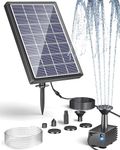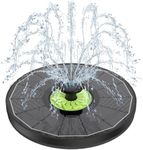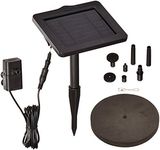Buying Guide for the Best Solar Fountains
Solar fountains are a great way to add a touch of elegance and tranquility to your garden or outdoor space while being environmentally friendly. They harness solar energy to power the pump, eliminating the need for electricity and reducing your carbon footprint. When choosing a solar fountain, it's important to consider several key specifications to ensure you select the best fit for your needs and preferences. Understanding these specifications will help you make an informed decision and enjoy the benefits of a solar-powered water feature.Solar Panel TypeThe solar panel is the component that captures sunlight and converts it into energy to power the fountain. There are generally two types of solar panels used in fountains: monocrystalline and polycrystalline. Monocrystalline panels are more efficient and perform better in low-light conditions, making them ideal if your garden doesn't receive full sun all day. Polycrystalline panels are less efficient but are usually more affordable. Consider the amount of sunlight your location receives and choose a panel type that will provide consistent performance.
Pump PowerThe pump power determines how much water the fountain can circulate and how high the water can be lifted. It is usually measured in gallons per hour (GPH). A higher GPH means a stronger flow and potentially a more dramatic water display. If you prefer a gentle trickle, a lower GPH will suffice. Consider the size of your fountain and the desired water effect when choosing the pump power. Larger fountains or those with multiple tiers may require a more powerful pump to achieve the desired effect.
Battery BackupA battery backup allows the fountain to operate even when the sun isn't shining, such as during cloudy days or at night. This feature is important if you want your fountain to run continuously regardless of weather conditions. Some solar fountains come with built-in batteries that store excess energy, while others may not include this feature. If you want uninterrupted operation, look for a model with a reliable battery backup system.
MaterialThe material of the fountain affects its durability, appearance, and maintenance requirements. Common materials include resin, ceramic, metal, and stone. Resin is lightweight and can mimic the appearance of more expensive materials, but it may not be as durable. Ceramic offers a classic look but can be fragile. Metal is durable but may require more maintenance to prevent rust. Stone is very durable and offers a natural look but can be heavy and more expensive. Consider the aesthetic you want to achieve and the level of maintenance you're willing to perform.
Design and StyleThe design and style of the solar fountain should complement your outdoor space and personal taste. Fountains come in a variety of styles, from modern and minimalist to classic and ornate. Consider the overall theme of your garden or patio and choose a design that enhances it. Additionally, think about the size and placement of the fountain to ensure it fits well within your space without overwhelming it.













